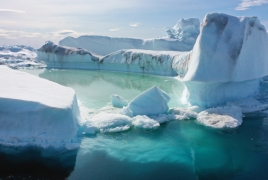
The Greenland Ice Sheet saw a sharp spike in the rate and extent of melting last week, with 18 billion tons of water running into the North Atlantic in just three days. Satellite photos reveal melt ponds dotting the ice cover, particularly near the coasts, Axios reports.
Greenland's melting ice is the top annual contributor to global sea level rise. How much of and how quickly the ice sheet is lost will determine the fate of coastal cities from Hong Kong to Miami.
An uptick in ice loss that occurred during the July 15-17 period sent enough water careening off the ice sheet to fill 2.4 million Olympic-sized swimming pools, said Ted Scambos, a climate scientist at the University of Colorado at Boulder, in an interview.
Put another way, it was the equivalent of covering all of West Virginia in four inches of water per day, for a total of 1 foot.
While this sounds extreme, Scambos said it doesn't rank as the highest melt surge scientists have witnessed in recent years. Periods of exceptionally mild weather, even at the highest reaches of the ice sheet, have become common since about the year 2010, which some researchers find unnerving.
Context: "Since 2010, especially 2012, there have been lots of very extensive melt events," Scambos said, noting that northern Greenland, which was involved in the most recent event, has been seeing increasing intrusions of milder air and higher melt rates.
"This was a widespread event," he said. "Overall, it continues to indicate that Greenland is trending towards more melting than was the case in the 1980s and 1990s."
Scambos tied the most recent event to an unusually mild air mass that moved across the ice sheet from northern Canada, and not Europe's scorching heat wave. During it, the temperature reached 34°F (1.1°C) at a high-altitude weather station on the ice sheet, which is unusual for that location.

